Tourism Development Report: London Olympiad Case Study Analysis
VerifiedAdded on 2020/02/12
|18
|4626
|28
Report
AI Summary
This report provides a comprehensive analysis of tourism development, using the London Olympiad as a central case study. It begins by discussing stakeholder benefits derived from tourism planning and examines the advantages and disadvantages of public-private sector partnerships within the context of the London Olympics. The report then analyzes tourism development planning at various levels, including sub-regional, regional, national, and international, and evaluates the significance of interactive planning systems. It also explores different methods for measuring tourist impact, such as survey methods and satellite accounts. Furthermore, the report delves into the concept of sustainability in tourism, justifying its introduction and analyzing factors that may hinder sustainable development. It also examines the stages involved in planning for sustainability, again using the London Olympiad as a reference point. The report concludes by evaluating methods of resolving conflicts of interest in developing tourism destinations like Casa de Campo, analyzing the implications of balancing supply and demand, and evaluating the ethical issues of enclave tourism. The report also compares current issues in tourism development in developing countries and offers recommendations for future tourism development in chosen destinations.
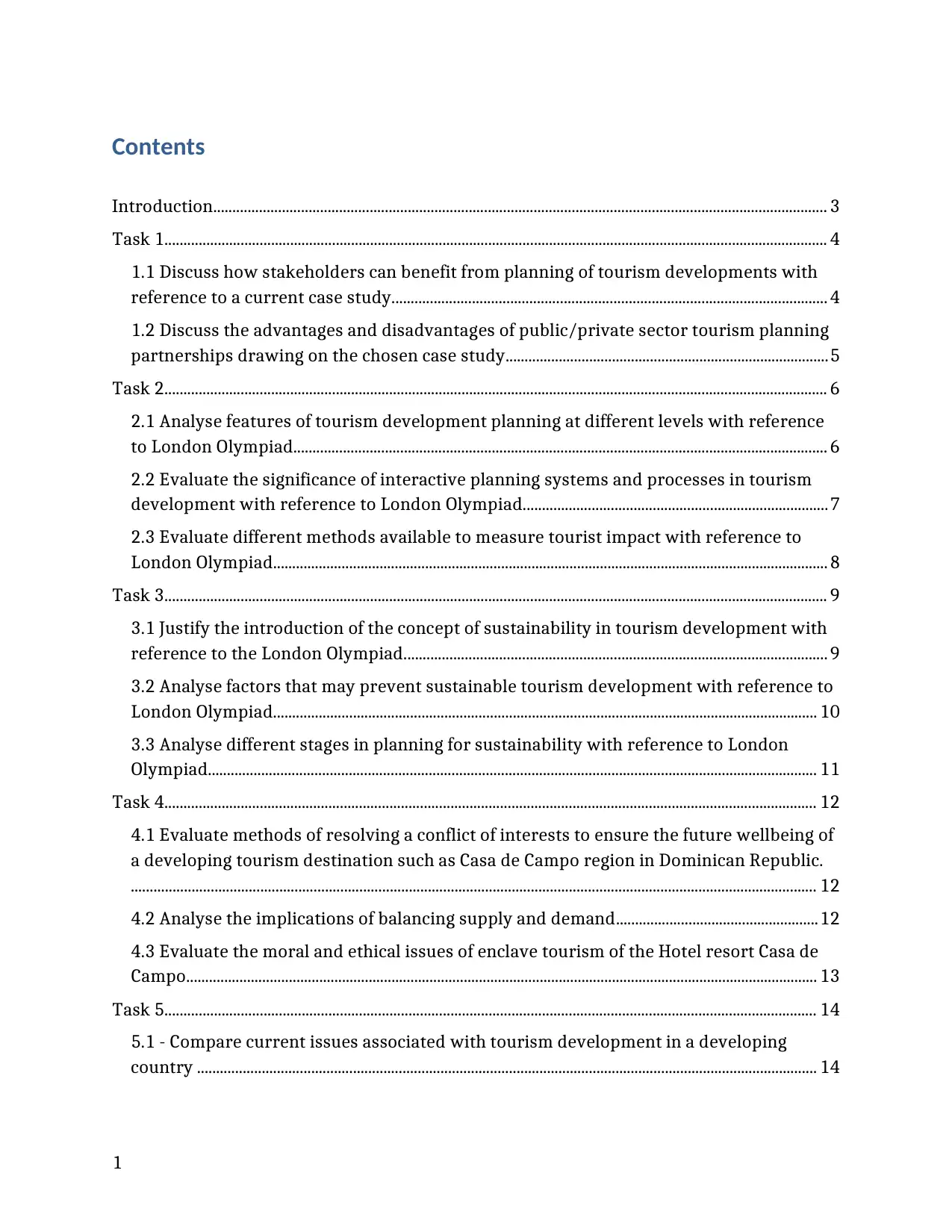
Contents
Introduction................................................................................................................................................................. 3
Task 1.............................................................................................................................................................................. 4
1.1 Discuss how stakeholders can benefit from planning of tourism developments with
reference to a current case study.................................................................................................................. 4
1.2 Discuss the advantages and disadvantages of public/private sector tourism planning
partnerships drawing on the chosen case study.....................................................................................5
Task 2.............................................................................................................................................................................. 6
2.1 Analyse features of tourism development planning at different levels with reference
to London Olympiad............................................................................................................................................ 6
2.2 Evaluate the significance of interactive planning systems and processes in tourism
development with reference to London Olympiad................................................................................7
2.3 Evaluate different methods available to measure tourist impact with reference to
London Olympiad.................................................................................................................................................. 8
Task 3.............................................................................................................................................................................. 9
3.1 Justify the introduction of the concept of sustainability in tourism development with
reference to the London Olympiad............................................................................................................... 9
3.2 Analyse factors that may prevent sustainable tourism development with reference to
London Olympiad............................................................................................................................................... 10
3.3 Analyse different stages in planning for sustainability with reference to London
Olympiad................................................................................................................................................................ 11
Task 4........................................................................................................................................................................... 12
4.1 Evaluate methods of resolving a conflict of interests to ensure the future wellbeing of
a developing tourism destination such as Casa de Campo region in Dominican Republic.
.................................................................................................................................................................................... 12
4.2 Analyse the implications of balancing supply and demand.....................................................12
4.3 Evaluate the moral and ethical issues of enclave tourism of the Hotel resort Casa de
Campo...................................................................................................................................................................... 13
Task 5........................................................................................................................................................................... 14
5.1 - Compare current issues associated with tourism development in a developing
country ................................................................................................................................................................... 14
1
Introduction................................................................................................................................................................. 3
Task 1.............................................................................................................................................................................. 4
1.1 Discuss how stakeholders can benefit from planning of tourism developments with
reference to a current case study.................................................................................................................. 4
1.2 Discuss the advantages and disadvantages of public/private sector tourism planning
partnerships drawing on the chosen case study.....................................................................................5
Task 2.............................................................................................................................................................................. 6
2.1 Analyse features of tourism development planning at different levels with reference
to London Olympiad............................................................................................................................................ 6
2.2 Evaluate the significance of interactive planning systems and processes in tourism
development with reference to London Olympiad................................................................................7
2.3 Evaluate different methods available to measure tourist impact with reference to
London Olympiad.................................................................................................................................................. 8
Task 3.............................................................................................................................................................................. 9
3.1 Justify the introduction of the concept of sustainability in tourism development with
reference to the London Olympiad............................................................................................................... 9
3.2 Analyse factors that may prevent sustainable tourism development with reference to
London Olympiad............................................................................................................................................... 10
3.3 Analyse different stages in planning for sustainability with reference to London
Olympiad................................................................................................................................................................ 11
Task 4........................................................................................................................................................................... 12
4.1 Evaluate methods of resolving a conflict of interests to ensure the future wellbeing of
a developing tourism destination such as Casa de Campo region in Dominican Republic.
.................................................................................................................................................................................... 12
4.2 Analyse the implications of balancing supply and demand.....................................................12
4.3 Evaluate the moral and ethical issues of enclave tourism of the Hotel resort Casa de
Campo...................................................................................................................................................................... 13
Task 5........................................................................................................................................................................... 14
5.1 - Compare current issues associated with tourism development in a developing
country ................................................................................................................................................................... 14
1
Paraphrase This Document
Need a fresh take? Get an instant paraphrase of this document with our AI Paraphraser
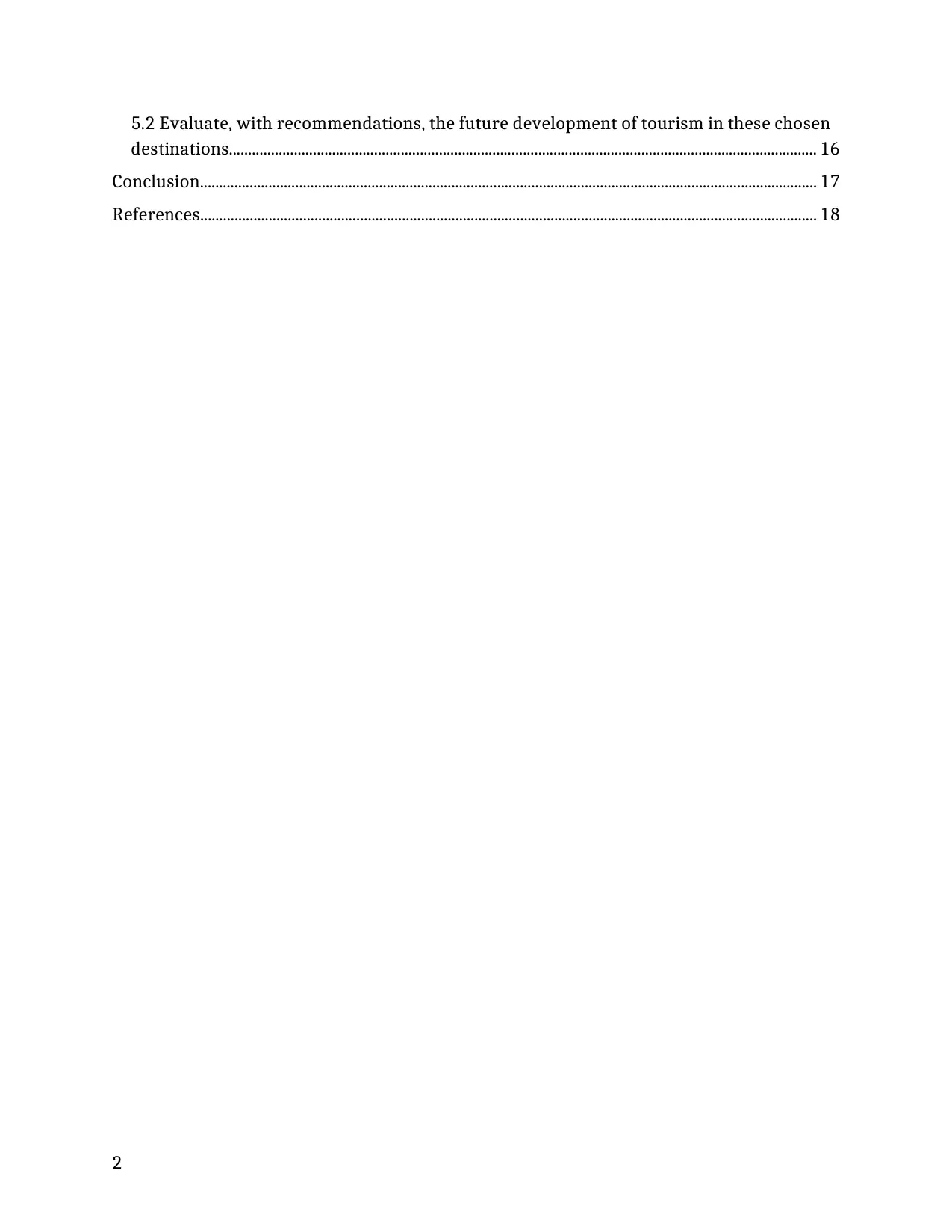
5.2 Evaluate, with recommendations, the future development of tourism in these chosen
destinations.......................................................................................................................................................... 16
Conclusion.................................................................................................................................................................. 17
References.................................................................................................................................................................. 18
2
destinations.......................................................................................................................................................... 16
Conclusion.................................................................................................................................................................. 17
References.................................................................................................................................................................. 18
2
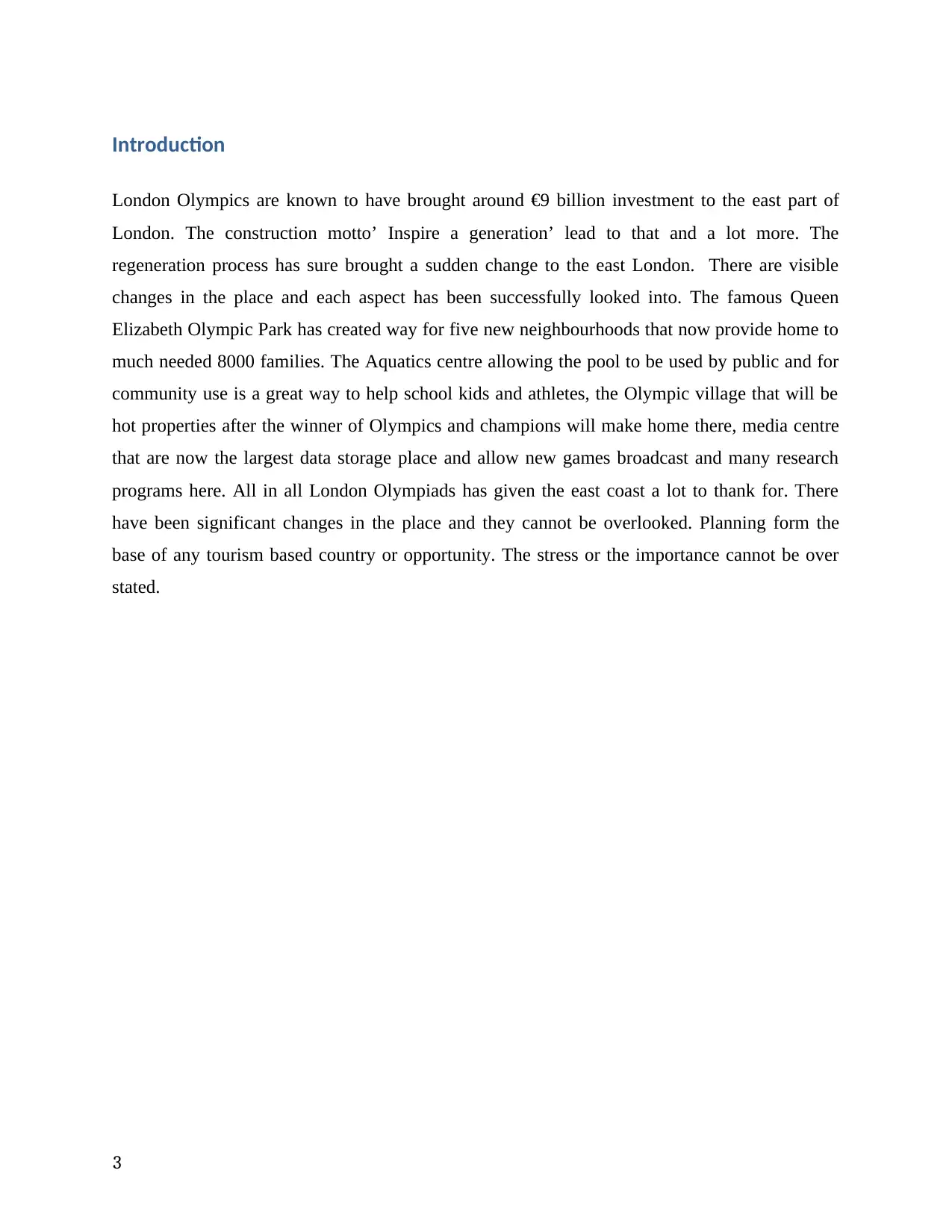
Introduction
London Olympics are known to have brought around €9 billion investment to the east part of
London. The construction motto’ Inspire a generation’ lead to that and a lot more. The
regeneration process has sure brought a sudden change to the east London. There are visible
changes in the place and each aspect has been successfully looked into. The famous Queen
Elizabeth Olympic Park has created way for five new neighbourhoods that now provide home to
much needed 8000 families. The Aquatics centre allowing the pool to be used by public and for
community use is a great way to help school kids and athletes, the Olympic village that will be
hot properties after the winner of Olympics and champions will make home there, media centre
that are now the largest data storage place and allow new games broadcast and many research
programs here. All in all London Olympiads has given the east coast a lot to thank for. There
have been significant changes in the place and they cannot be overlooked. Planning form the
base of any tourism based country or opportunity. The stress or the importance cannot be over
stated.
3
London Olympics are known to have brought around €9 billion investment to the east part of
London. The construction motto’ Inspire a generation’ lead to that and a lot more. The
regeneration process has sure brought a sudden change to the east London. There are visible
changes in the place and each aspect has been successfully looked into. The famous Queen
Elizabeth Olympic Park has created way for five new neighbourhoods that now provide home to
much needed 8000 families. The Aquatics centre allowing the pool to be used by public and for
community use is a great way to help school kids and athletes, the Olympic village that will be
hot properties after the winner of Olympics and champions will make home there, media centre
that are now the largest data storage place and allow new games broadcast and many research
programs here. All in all London Olympiads has given the east coast a lot to thank for. There
have been significant changes in the place and they cannot be overlooked. Planning form the
base of any tourism based country or opportunity. The stress or the importance cannot be over
stated.
3
⊘ This is a preview!⊘
Do you want full access?
Subscribe today to unlock all pages.

Trusted by 1+ million students worldwide
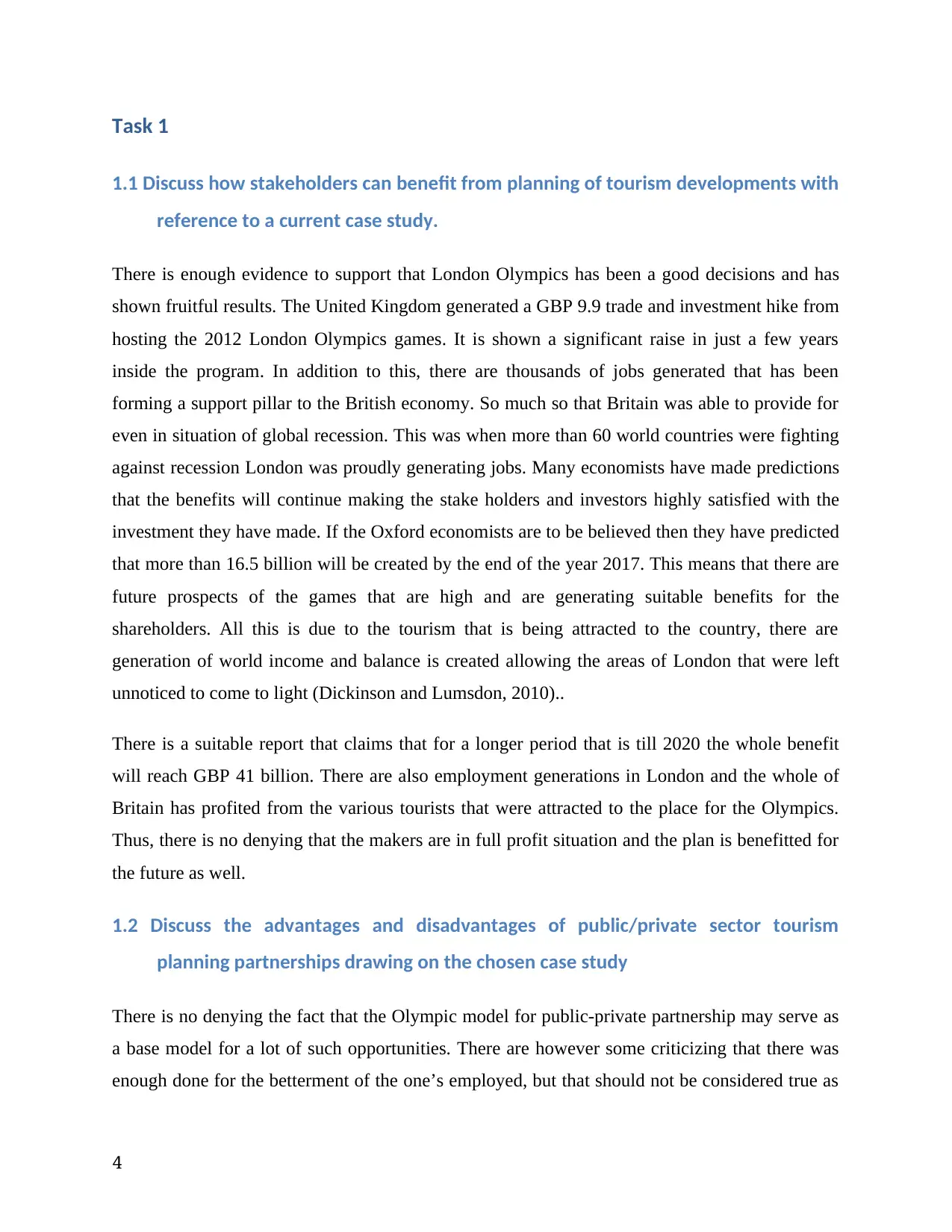
Task 1
1.1 Discuss how stakeholders can benefit from planning of tourism developments with
reference to a current case study.
There is enough evidence to support that London Olympics has been a good decisions and has
shown fruitful results. The United Kingdom generated a GBP 9.9 trade and investment hike from
hosting the 2012 London Olympics games. It is shown a significant raise in just a few years
inside the program. In addition to this, there are thousands of jobs generated that has been
forming a support pillar to the British economy. So much so that Britain was able to provide for
even in situation of global recession. This was when more than 60 world countries were fighting
against recession London was proudly generating jobs. Many economists have made predictions
that the benefits will continue making the stake holders and investors highly satisfied with the
investment they have made. If the Oxford economists are to be believed then they have predicted
that more than 16.5 billion will be created by the end of the year 2017. This means that there are
future prospects of the games that are high and are generating suitable benefits for the
shareholders. All this is due to the tourism that is being attracted to the country, there are
generation of world income and balance is created allowing the areas of London that were left
unnoticed to come to light (Dickinson and Lumsdon, 2010)..
There is a suitable report that claims that for a longer period that is till 2020 the whole benefit
will reach GBP 41 billion. There are also employment generations in London and the whole of
Britain has profited from the various tourists that were attracted to the place for the Olympics.
Thus, there is no denying that the makers are in full profit situation and the plan is benefitted for
the future as well.
1.2 Discuss the advantages and disadvantages of public/private sector tourism
planning partnerships drawing on the chosen case study
There is no denying the fact that the Olympic model for public-private partnership may serve as
a base model for a lot of such opportunities. There are however some criticizing that there was
enough done for the betterment of the one’s employed, but that should not be considered true as
4
1.1 Discuss how stakeholders can benefit from planning of tourism developments with
reference to a current case study.
There is enough evidence to support that London Olympics has been a good decisions and has
shown fruitful results. The United Kingdom generated a GBP 9.9 trade and investment hike from
hosting the 2012 London Olympics games. It is shown a significant raise in just a few years
inside the program. In addition to this, there are thousands of jobs generated that has been
forming a support pillar to the British economy. So much so that Britain was able to provide for
even in situation of global recession. This was when more than 60 world countries were fighting
against recession London was proudly generating jobs. Many economists have made predictions
that the benefits will continue making the stake holders and investors highly satisfied with the
investment they have made. If the Oxford economists are to be believed then they have predicted
that more than 16.5 billion will be created by the end of the year 2017. This means that there are
future prospects of the games that are high and are generating suitable benefits for the
shareholders. All this is due to the tourism that is being attracted to the country, there are
generation of world income and balance is created allowing the areas of London that were left
unnoticed to come to light (Dickinson and Lumsdon, 2010)..
There is a suitable report that claims that for a longer period that is till 2020 the whole benefit
will reach GBP 41 billion. There are also employment generations in London and the whole of
Britain has profited from the various tourists that were attracted to the place for the Olympics.
Thus, there is no denying that the makers are in full profit situation and the plan is benefitted for
the future as well.
1.2 Discuss the advantages and disadvantages of public/private sector tourism
planning partnerships drawing on the chosen case study
There is no denying the fact that the Olympic model for public-private partnership may serve as
a base model for a lot of such opportunities. There are however some criticizing that there was
enough done for the betterment of the one’s employed, but that should not be considered true as
4
Paraphrase This Document
Need a fresh take? Get an instant paraphrase of this document with our AI Paraphraser
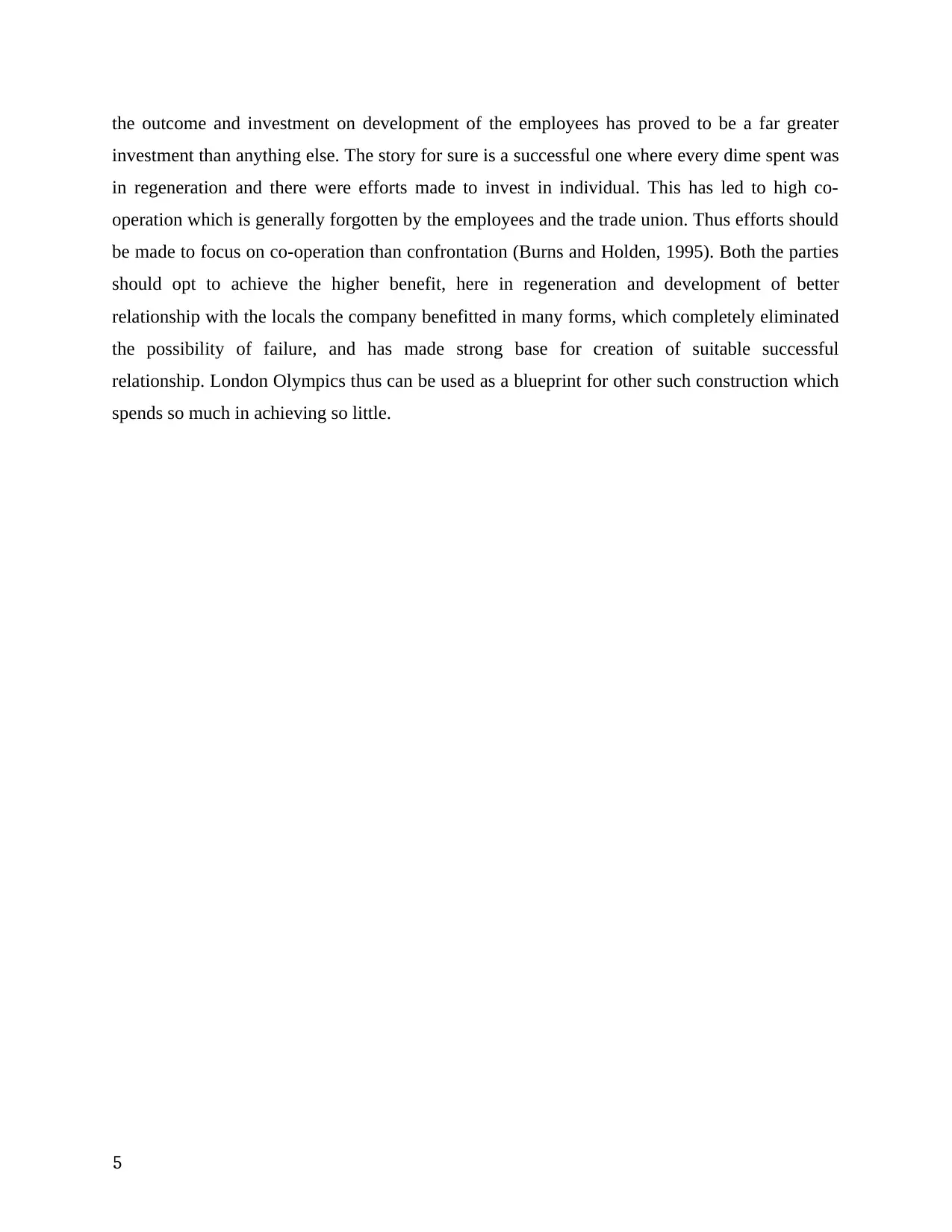
the outcome and investment on development of the employees has proved to be a far greater
investment than anything else. The story for sure is a successful one where every dime spent was
in regeneration and there were efforts made to invest in individual. This has led to high co-
operation which is generally forgotten by the employees and the trade union. Thus efforts should
be made to focus on co-operation than confrontation (Burns and Holden, 1995). Both the parties
should opt to achieve the higher benefit, here in regeneration and development of better
relationship with the locals the company benefitted in many forms, which completely eliminated
the possibility of failure, and has made strong base for creation of suitable successful
relationship. London Olympics thus can be used as a blueprint for other such construction which
spends so much in achieving so little.
5
investment than anything else. The story for sure is a successful one where every dime spent was
in regeneration and there were efforts made to invest in individual. This has led to high co-
operation which is generally forgotten by the employees and the trade union. Thus efforts should
be made to focus on co-operation than confrontation (Burns and Holden, 1995). Both the parties
should opt to achieve the higher benefit, here in regeneration and development of better
relationship with the locals the company benefitted in many forms, which completely eliminated
the possibility of failure, and has made strong base for creation of suitable successful
relationship. London Olympics thus can be used as a blueprint for other such construction which
spends so much in achieving so little.
5
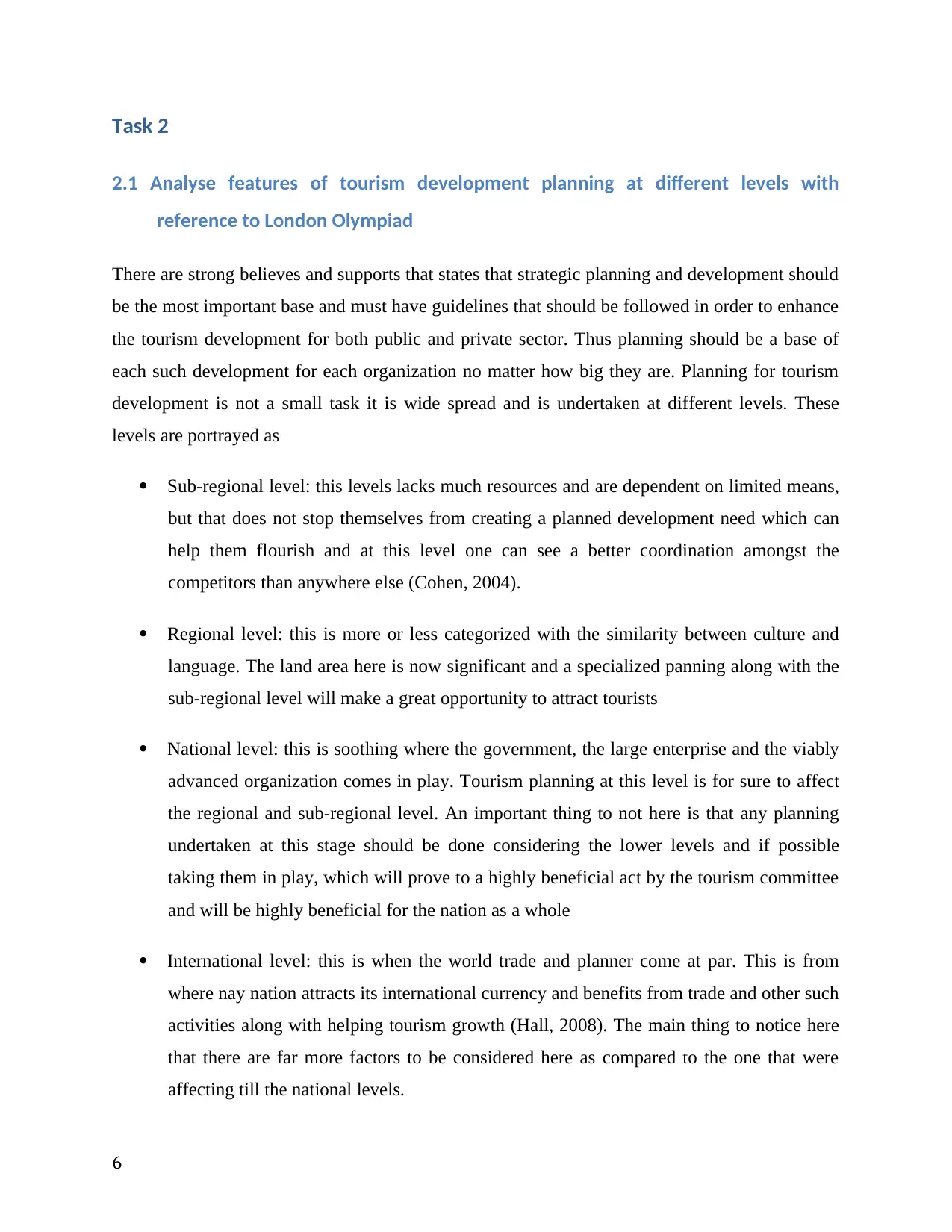
Task 2
2.1 Analyse features of tourism development planning at different levels with
reference to London Olympiad
There are strong believes and supports that states that strategic planning and development should
be the most important base and must have guidelines that should be followed in order to enhance
the tourism development for both public and private sector. Thus planning should be a base of
each such development for each organization no matter how big they are. Planning for tourism
development is not a small task it is wide spread and is undertaken at different levels. These
levels are portrayed as
Sub-regional level: this levels lacks much resources and are dependent on limited means,
but that does not stop themselves from creating a planned development need which can
help them flourish and at this level one can see a better coordination amongst the
competitors than anywhere else (Cohen, 2004).
Regional level: this is more or less categorized with the similarity between culture and
language. The land area here is now significant and a specialized panning along with the
sub-regional level will make a great opportunity to attract tourists
National level: this is soothing where the government, the large enterprise and the viably
advanced organization comes in play. Tourism planning at this level is for sure to affect
the regional and sub-regional level. An important thing to not here is that any planning
undertaken at this stage should be done considering the lower levels and if possible
taking them in play, which will prove to a highly beneficial act by the tourism committee
and will be highly beneficial for the nation as a whole
International level: this is when the world trade and planner come at par. This is from
where nay nation attracts its international currency and benefits from trade and other such
activities along with helping tourism growth (Hall, 2008). The main thing to notice here
that there are far more factors to be considered here as compared to the one that were
affecting till the national levels.
6
2.1 Analyse features of tourism development planning at different levels with
reference to London Olympiad
There are strong believes and supports that states that strategic planning and development should
be the most important base and must have guidelines that should be followed in order to enhance
the tourism development for both public and private sector. Thus planning should be a base of
each such development for each organization no matter how big they are. Planning for tourism
development is not a small task it is wide spread and is undertaken at different levels. These
levels are portrayed as
Sub-regional level: this levels lacks much resources and are dependent on limited means,
but that does not stop themselves from creating a planned development need which can
help them flourish and at this level one can see a better coordination amongst the
competitors than anywhere else (Cohen, 2004).
Regional level: this is more or less categorized with the similarity between culture and
language. The land area here is now significant and a specialized panning along with the
sub-regional level will make a great opportunity to attract tourists
National level: this is soothing where the government, the large enterprise and the viably
advanced organization comes in play. Tourism planning at this level is for sure to affect
the regional and sub-regional level. An important thing to not here is that any planning
undertaken at this stage should be done considering the lower levels and if possible
taking them in play, which will prove to a highly beneficial act by the tourism committee
and will be highly beneficial for the nation as a whole
International level: this is when the world trade and planner come at par. This is from
where nay nation attracts its international currency and benefits from trade and other such
activities along with helping tourism growth (Hall, 2008). The main thing to notice here
that there are far more factors to be considered here as compared to the one that were
affecting till the national levels.
6
⊘ This is a preview!⊘
Do you want full access?
Subscribe today to unlock all pages.

Trusted by 1+ million students worldwide
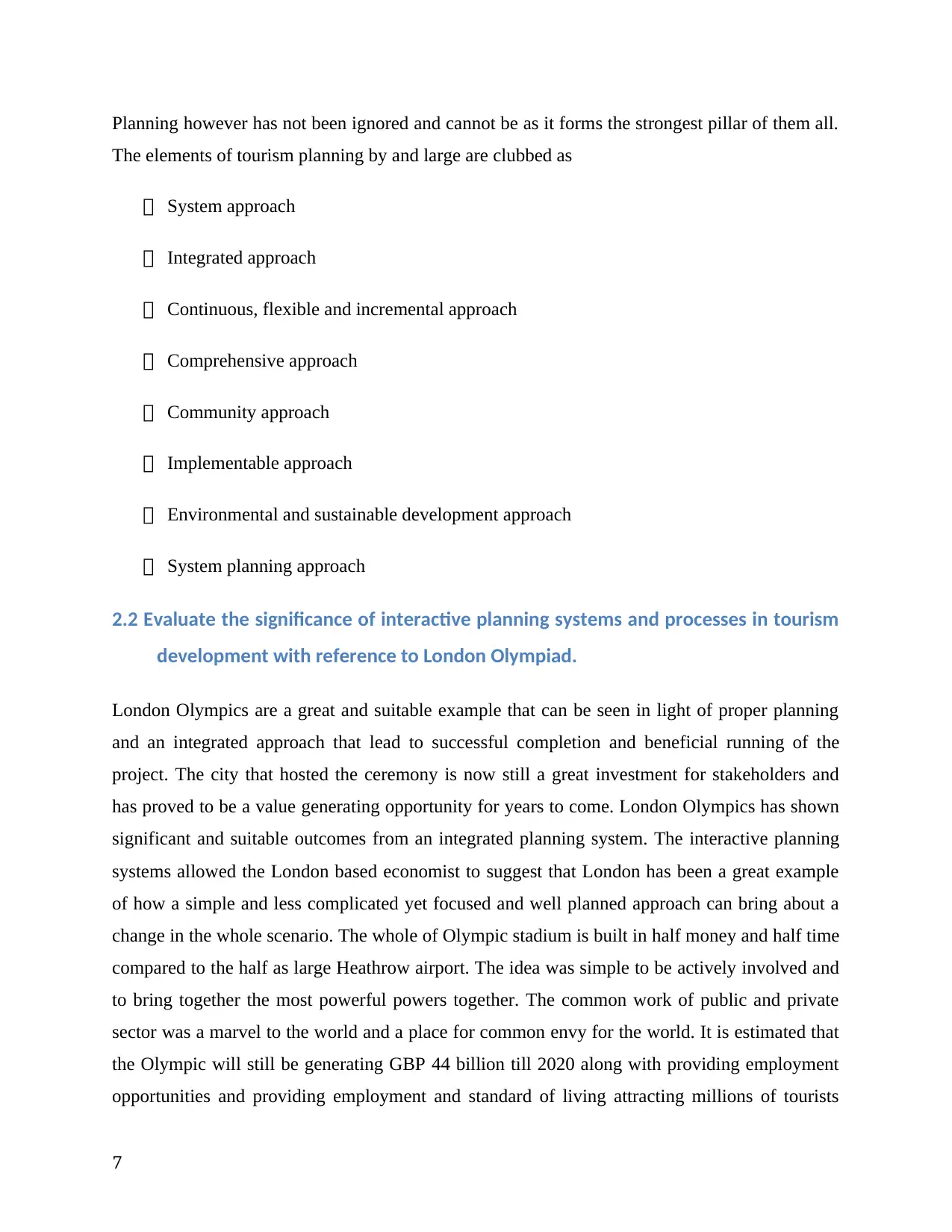
Planning however has not been ignored and cannot be as it forms the strongest pillar of them all.
The elements of tourism planning by and large are clubbed as
System approach
Integrated approach
Continuous, flexible and incremental approach
Comprehensive approach
Community approach
Implementable approach
Environmental and sustainable development approach
System planning approach
2.2 Evaluate the significance of interactive planning systems and processes in tourism
development with reference to London Olympiad.
London Olympics are a great and suitable example that can be seen in light of proper planning
and an integrated approach that lead to successful completion and beneficial running of the
project. The city that hosted the ceremony is now still a great investment for stakeholders and
has proved to be a value generating opportunity for years to come. London Olympics has shown
significant and suitable outcomes from an integrated planning system. The interactive planning
systems allowed the London based economist to suggest that London has been a great example
of how a simple and less complicated yet focused and well planned approach can bring about a
change in the whole scenario. The whole of Olympic stadium is built in half money and half time
compared to the half as large Heathrow airport. The idea was simple to be actively involved and
to bring together the most powerful powers together. The common work of public and private
sector was a marvel to the world and a place for common envy for the world. It is estimated that
the Olympic will still be generating GBP 44 billion till 2020 along with providing employment
opportunities and providing employment and standard of living attracting millions of tourists
7
The elements of tourism planning by and large are clubbed as
System approach
Integrated approach
Continuous, flexible and incremental approach
Comprehensive approach
Community approach
Implementable approach
Environmental and sustainable development approach
System planning approach
2.2 Evaluate the significance of interactive planning systems and processes in tourism
development with reference to London Olympiad.
London Olympics are a great and suitable example that can be seen in light of proper planning
and an integrated approach that lead to successful completion and beneficial running of the
project. The city that hosted the ceremony is now still a great investment for stakeholders and
has proved to be a value generating opportunity for years to come. London Olympics has shown
significant and suitable outcomes from an integrated planning system. The interactive planning
systems allowed the London based economist to suggest that London has been a great example
of how a simple and less complicated yet focused and well planned approach can bring about a
change in the whole scenario. The whole of Olympic stadium is built in half money and half time
compared to the half as large Heathrow airport. The idea was simple to be actively involved and
to bring together the most powerful powers together. The common work of public and private
sector was a marvel to the world and a place for common envy for the world. It is estimated that
the Olympic will still be generating GBP 44 billion till 2020 along with providing employment
opportunities and providing employment and standard of living attracting millions of tourists
7
Paraphrase This Document
Need a fresh take? Get an instant paraphrase of this document with our AI Paraphraser
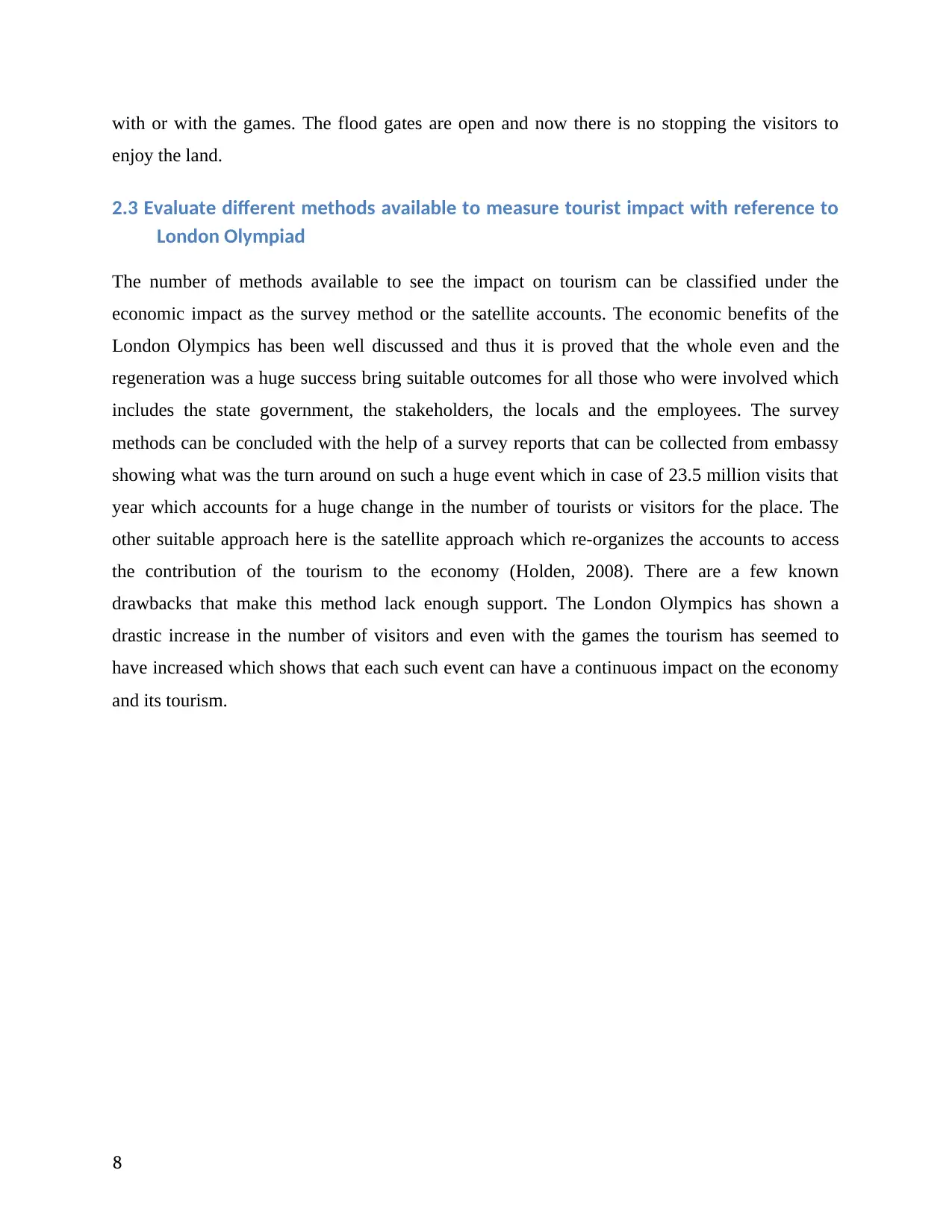
with or with the games. The flood gates are open and now there is no stopping the visitors to
enjoy the land.
2.3 Evaluate different methods available to measure tourist impact with reference to
London Olympiad
The number of methods available to see the impact on tourism can be classified under the
economic impact as the survey method or the satellite accounts. The economic benefits of the
London Olympics has been well discussed and thus it is proved that the whole even and the
regeneration was a huge success bring suitable outcomes for all those who were involved which
includes the state government, the stakeholders, the locals and the employees. The survey
methods can be concluded with the help of a survey reports that can be collected from embassy
showing what was the turn around on such a huge event which in case of 23.5 million visits that
year which accounts for a huge change in the number of tourists or visitors for the place. The
other suitable approach here is the satellite approach which re-organizes the accounts to access
the contribution of the tourism to the economy (Holden, 2008). There are a few known
drawbacks that make this method lack enough support. The London Olympics has shown a
drastic increase in the number of visitors and even with the games the tourism has seemed to
have increased which shows that each such event can have a continuous impact on the economy
and its tourism.
8
enjoy the land.
2.3 Evaluate different methods available to measure tourist impact with reference to
London Olympiad
The number of methods available to see the impact on tourism can be classified under the
economic impact as the survey method or the satellite accounts. The economic benefits of the
London Olympics has been well discussed and thus it is proved that the whole even and the
regeneration was a huge success bring suitable outcomes for all those who were involved which
includes the state government, the stakeholders, the locals and the employees. The survey
methods can be concluded with the help of a survey reports that can be collected from embassy
showing what was the turn around on such a huge event which in case of 23.5 million visits that
year which accounts for a huge change in the number of tourists or visitors for the place. The
other suitable approach here is the satellite approach which re-organizes the accounts to access
the contribution of the tourism to the economy (Holden, 2008). There are a few known
drawbacks that make this method lack enough support. The London Olympics has shown a
drastic increase in the number of visitors and even with the games the tourism has seemed to
have increased which shows that each such event can have a continuous impact on the economy
and its tourism.
8
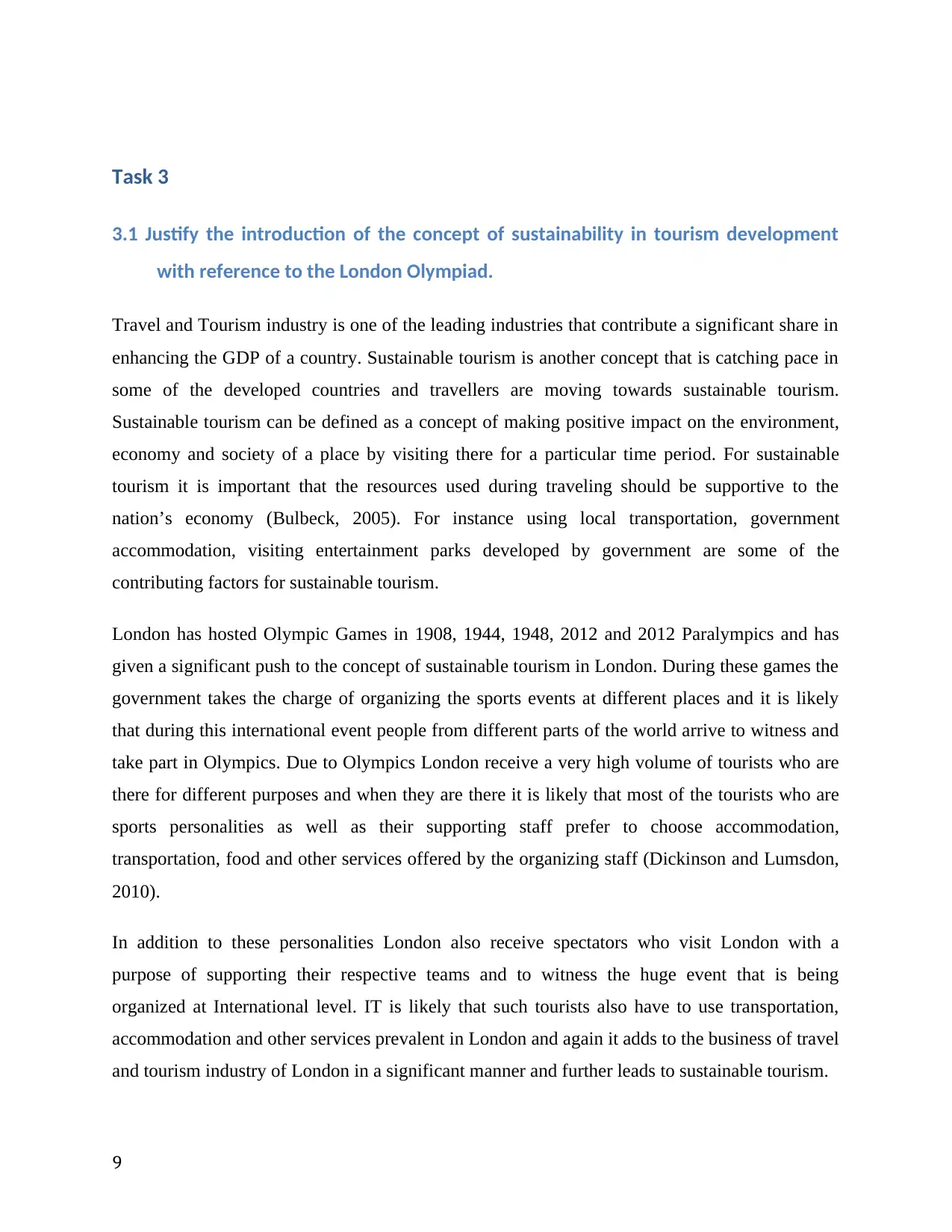
Task 3
3.1 Justify the introduction of the concept of sustainability in tourism development
with reference to the London Olympiad.
Travel and Tourism industry is one of the leading industries that contribute a significant share in
enhancing the GDP of a country. Sustainable tourism is another concept that is catching pace in
some of the developed countries and travellers are moving towards sustainable tourism.
Sustainable tourism can be defined as a concept of making positive impact on the environment,
economy and society of a place by visiting there for a particular time period. For sustainable
tourism it is important that the resources used during traveling should be supportive to the
nation’s economy (Bulbeck, 2005). For instance using local transportation, government
accommodation, visiting entertainment parks developed by government are some of the
contributing factors for sustainable tourism.
London has hosted Olympic Games in 1908, 1944, 1948, 2012 and 2012 Paralympics and has
given a significant push to the concept of sustainable tourism in London. During these games the
government takes the charge of organizing the sports events at different places and it is likely
that during this international event people from different parts of the world arrive to witness and
take part in Olympics. Due to Olympics London receive a very high volume of tourists who are
there for different purposes and when they are there it is likely that most of the tourists who are
sports personalities as well as their supporting staff prefer to choose accommodation,
transportation, food and other services offered by the organizing staff (Dickinson and Lumsdon,
2010).
In addition to these personalities London also receive spectators who visit London with a
purpose of supporting their respective teams and to witness the huge event that is being
organized at International level. IT is likely that such tourists also have to use transportation,
accommodation and other services prevalent in London and again it adds to the business of travel
and tourism industry of London in a significant manner and further leads to sustainable tourism.
9
3.1 Justify the introduction of the concept of sustainability in tourism development
with reference to the London Olympiad.
Travel and Tourism industry is one of the leading industries that contribute a significant share in
enhancing the GDP of a country. Sustainable tourism is another concept that is catching pace in
some of the developed countries and travellers are moving towards sustainable tourism.
Sustainable tourism can be defined as a concept of making positive impact on the environment,
economy and society of a place by visiting there for a particular time period. For sustainable
tourism it is important that the resources used during traveling should be supportive to the
nation’s economy (Bulbeck, 2005). For instance using local transportation, government
accommodation, visiting entertainment parks developed by government are some of the
contributing factors for sustainable tourism.
London has hosted Olympic Games in 1908, 1944, 1948, 2012 and 2012 Paralympics and has
given a significant push to the concept of sustainable tourism in London. During these games the
government takes the charge of organizing the sports events at different places and it is likely
that during this international event people from different parts of the world arrive to witness and
take part in Olympics. Due to Olympics London receive a very high volume of tourists who are
there for different purposes and when they are there it is likely that most of the tourists who are
sports personalities as well as their supporting staff prefer to choose accommodation,
transportation, food and other services offered by the organizing staff (Dickinson and Lumsdon,
2010).
In addition to these personalities London also receive spectators who visit London with a
purpose of supporting their respective teams and to witness the huge event that is being
organized at International level. IT is likely that such tourists also have to use transportation,
accommodation and other services prevalent in London and again it adds to the business of travel
and tourism industry of London in a significant manner and further leads to sustainable tourism.
9
⊘ This is a preview!⊘
Do you want full access?
Subscribe today to unlock all pages.

Trusted by 1+ million students worldwide
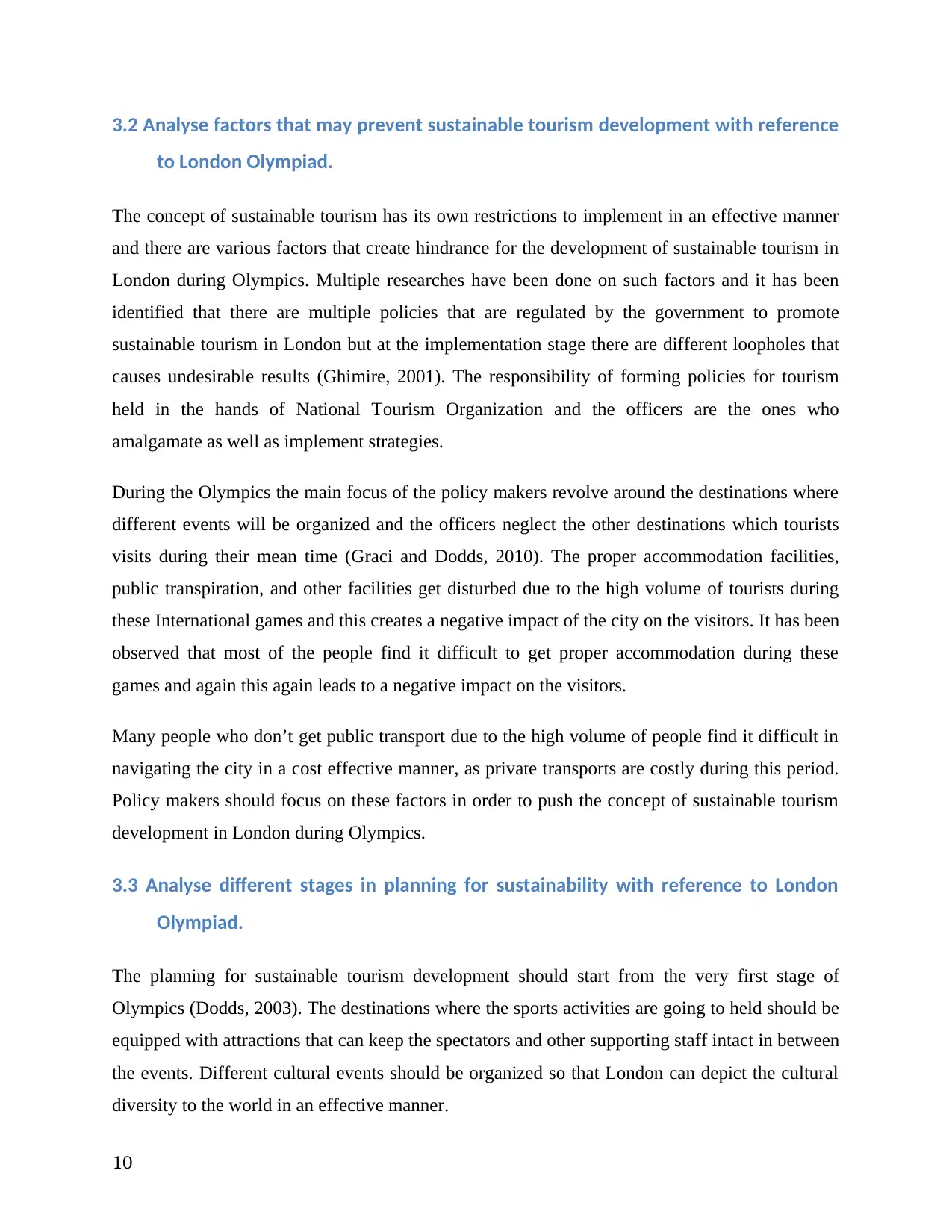
3.2 Analyse factors that may prevent sustainable tourism development with reference
to London Olympiad.
The concept of sustainable tourism has its own restrictions to implement in an effective manner
and there are various factors that create hindrance for the development of sustainable tourism in
London during Olympics. Multiple researches have been done on such factors and it has been
identified that there are multiple policies that are regulated by the government to promote
sustainable tourism in London but at the implementation stage there are different loopholes that
causes undesirable results (Ghimire, 2001). The responsibility of forming policies for tourism
held in the hands of National Tourism Organization and the officers are the ones who
amalgamate as well as implement strategies.
During the Olympics the main focus of the policy makers revolve around the destinations where
different events will be organized and the officers neglect the other destinations which tourists
visits during their mean time (Graci and Dodds, 2010). The proper accommodation facilities,
public transpiration, and other facilities get disturbed due to the high volume of tourists during
these International games and this creates a negative impact of the city on the visitors. It has been
observed that most of the people find it difficult to get proper accommodation during these
games and again this again leads to a negative impact on the visitors.
Many people who don’t get public transport due to the high volume of people find it difficult in
navigating the city in a cost effective manner, as private transports are costly during this period.
Policy makers should focus on these factors in order to push the concept of sustainable tourism
development in London during Olympics.
3.3 Analyse different stages in planning for sustainability with reference to London
Olympiad.
The planning for sustainable tourism development should start from the very first stage of
Olympics (Dodds, 2003). The destinations where the sports activities are going to held should be
equipped with attractions that can keep the spectators and other supporting staff intact in between
the events. Different cultural events should be organized so that London can depict the cultural
diversity to the world in an effective manner.
10
to London Olympiad.
The concept of sustainable tourism has its own restrictions to implement in an effective manner
and there are various factors that create hindrance for the development of sustainable tourism in
London during Olympics. Multiple researches have been done on such factors and it has been
identified that there are multiple policies that are regulated by the government to promote
sustainable tourism in London but at the implementation stage there are different loopholes that
causes undesirable results (Ghimire, 2001). The responsibility of forming policies for tourism
held in the hands of National Tourism Organization and the officers are the ones who
amalgamate as well as implement strategies.
During the Olympics the main focus of the policy makers revolve around the destinations where
different events will be organized and the officers neglect the other destinations which tourists
visits during their mean time (Graci and Dodds, 2010). The proper accommodation facilities,
public transpiration, and other facilities get disturbed due to the high volume of tourists during
these International games and this creates a negative impact of the city on the visitors. It has been
observed that most of the people find it difficult to get proper accommodation during these
games and again this again leads to a negative impact on the visitors.
Many people who don’t get public transport due to the high volume of people find it difficult in
navigating the city in a cost effective manner, as private transports are costly during this period.
Policy makers should focus on these factors in order to push the concept of sustainable tourism
development in London during Olympics.
3.3 Analyse different stages in planning for sustainability with reference to London
Olympiad.
The planning for sustainable tourism development should start from the very first stage of
Olympics (Dodds, 2003). The destinations where the sports activities are going to held should be
equipped with attractions that can keep the spectators and other supporting staff intact in between
the events. Different cultural events should be organized so that London can depict the cultural
diversity to the world in an effective manner.
10
Paraphrase This Document
Need a fresh take? Get an instant paraphrase of this document with our AI Paraphraser
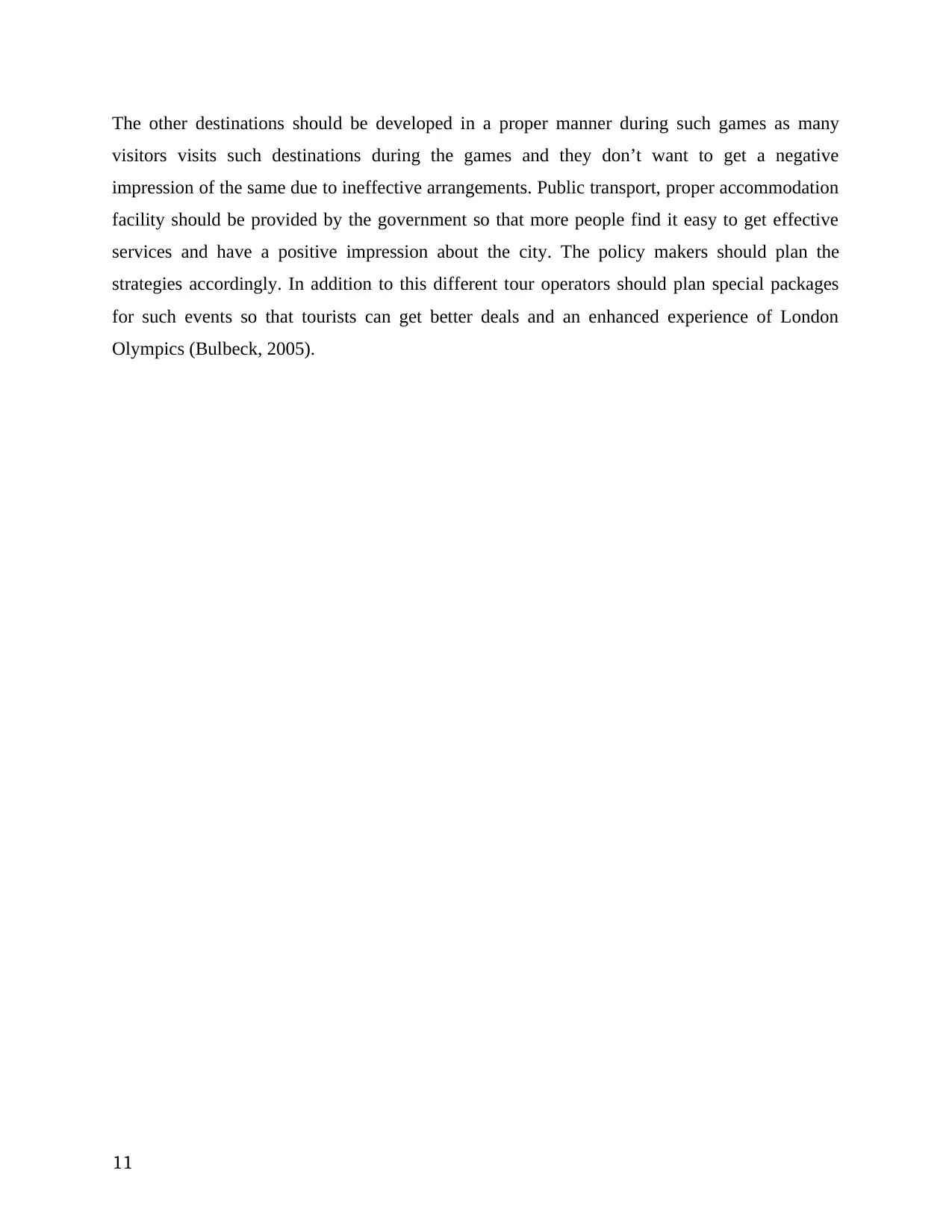
The other destinations should be developed in a proper manner during such games as many
visitors visits such destinations during the games and they don’t want to get a negative
impression of the same due to ineffective arrangements. Public transport, proper accommodation
facility should be provided by the government so that more people find it easy to get effective
services and have a positive impression about the city. The policy makers should plan the
strategies accordingly. In addition to this different tour operators should plan special packages
for such events so that tourists can get better deals and an enhanced experience of London
Olympics (Bulbeck, 2005).
11
visitors visits such destinations during the games and they don’t want to get a negative
impression of the same due to ineffective arrangements. Public transport, proper accommodation
facility should be provided by the government so that more people find it easy to get effective
services and have a positive impression about the city. The policy makers should plan the
strategies accordingly. In addition to this different tour operators should plan special packages
for such events so that tourists can get better deals and an enhanced experience of London
Olympics (Bulbeck, 2005).
11
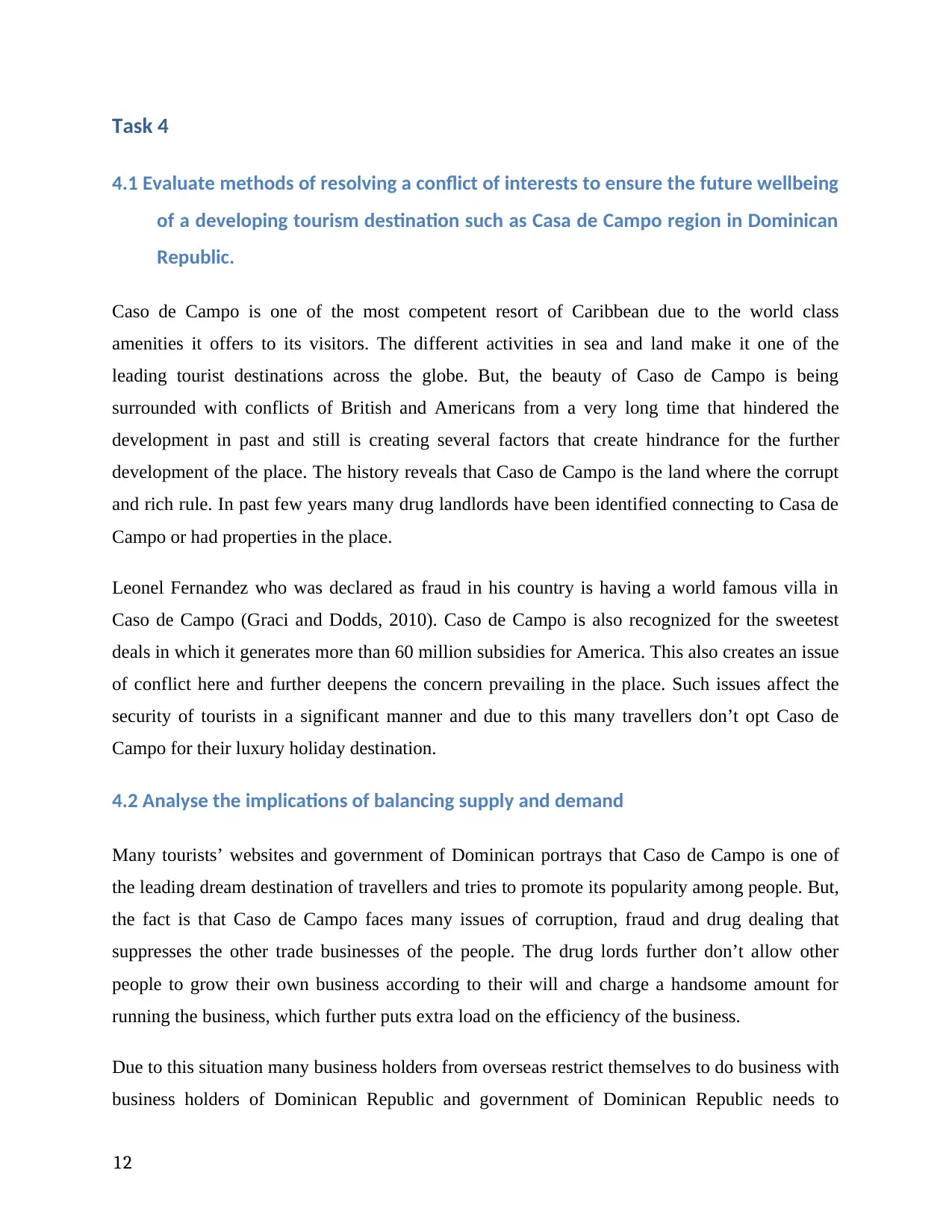
Task 4
4.1 Evaluate methods of resolving a conflict of interests to ensure the future wellbeing
of a developing tourism destination such as Casa de Campo region in Dominican
Republic.
Caso de Campo is one of the most competent resort of Caribbean due to the world class
amenities it offers to its visitors. The different activities in sea and land make it one of the
leading tourist destinations across the globe. But, the beauty of Caso de Campo is being
surrounded with conflicts of British and Americans from a very long time that hindered the
development in past and still is creating several factors that create hindrance for the further
development of the place. The history reveals that Caso de Campo is the land where the corrupt
and rich rule. In past few years many drug landlords have been identified connecting to Casa de
Campo or had properties in the place.
Leonel Fernandez who was declared as fraud in his country is having a world famous villa in
Caso de Campo (Graci and Dodds, 2010). Caso de Campo is also recognized for the sweetest
deals in which it generates more than 60 million subsidies for America. This also creates an issue
of conflict here and further deepens the concern prevailing in the place. Such issues affect the
security of tourists in a significant manner and due to this many travellers don’t opt Caso de
Campo for their luxury holiday destination.
4.2 Analyse the implications of balancing supply and demand
Many tourists’ websites and government of Dominican portrays that Caso de Campo is one of
the leading dream destination of travellers and tries to promote its popularity among people. But,
the fact is that Caso de Campo faces many issues of corruption, fraud and drug dealing that
suppresses the other trade businesses of the people. The drug lords further don’t allow other
people to grow their own business according to their will and charge a handsome amount for
running the business, which further puts extra load on the efficiency of the business.
Due to this situation many business holders from overseas restrict themselves to do business with
business holders of Dominican Republic and government of Dominican Republic needs to
12
4.1 Evaluate methods of resolving a conflict of interests to ensure the future wellbeing
of a developing tourism destination such as Casa de Campo region in Dominican
Republic.
Caso de Campo is one of the most competent resort of Caribbean due to the world class
amenities it offers to its visitors. The different activities in sea and land make it one of the
leading tourist destinations across the globe. But, the beauty of Caso de Campo is being
surrounded with conflicts of British and Americans from a very long time that hindered the
development in past and still is creating several factors that create hindrance for the further
development of the place. The history reveals that Caso de Campo is the land where the corrupt
and rich rule. In past few years many drug landlords have been identified connecting to Casa de
Campo or had properties in the place.
Leonel Fernandez who was declared as fraud in his country is having a world famous villa in
Caso de Campo (Graci and Dodds, 2010). Caso de Campo is also recognized for the sweetest
deals in which it generates more than 60 million subsidies for America. This also creates an issue
of conflict here and further deepens the concern prevailing in the place. Such issues affect the
security of tourists in a significant manner and due to this many travellers don’t opt Caso de
Campo for their luxury holiday destination.
4.2 Analyse the implications of balancing supply and demand
Many tourists’ websites and government of Dominican portrays that Caso de Campo is one of
the leading dream destination of travellers and tries to promote its popularity among people. But,
the fact is that Caso de Campo faces many issues of corruption, fraud and drug dealing that
suppresses the other trade businesses of the people. The drug lords further don’t allow other
people to grow their own business according to their will and charge a handsome amount for
running the business, which further puts extra load on the efficiency of the business.
Due to this situation many business holders from overseas restrict themselves to do business with
business holders of Dominican Republic and government of Dominican Republic needs to
12
⊘ This is a preview!⊘
Do you want full access?
Subscribe today to unlock all pages.

Trusted by 1+ million students worldwide
1 out of 18
Related Documents
Your All-in-One AI-Powered Toolkit for Academic Success.
+13062052269
info@desklib.com
Available 24*7 on WhatsApp / Email
![[object Object]](/_next/static/media/star-bottom.7253800d.svg)
Unlock your academic potential
Copyright © 2020–2025 A2Z Services. All Rights Reserved. Developed and managed by ZUCOL.





